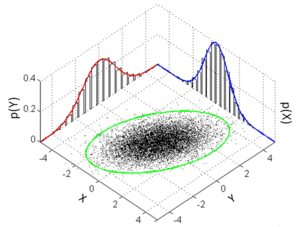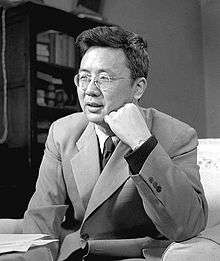Kai-Tai Fang
| Kai-Tai Fang | |
|---|---|
| Born |
1940 (age 75–76) Taizhou, Jiangsu, China |
| Fields | Statistics |
| Institutions | Hong Kong Baptist University, Chinese Academy of Sciences |
| Alma mater | Peking University |
| Doctoral advisor | Pao-Lu Hsu (许宝騄).[1] |
| Other academic advisors | Minyi Yue |
| Doctoral students | Chen Hang-feng, Fan Jianqing, Quan Hui, Wu Yue-hua, Xu Jing-Iun, Zhang Hong-qing[2][3] |
| Known for |
Elliptical distributions Generalized multivariate analysis Uniform experimental designs |
| Influences | Theodore W. Anderson, Yuan Wang |
| Notable awards | Elected Member of the ISI; Fellow of the IMS, HKSS,[4][5] and ASA;[6] President's Award for Outstanding Performance in Scholarly Work, HKBU;[5] most excellent book in China (Government Information and Publication Administration).[5] |
| Kai-Tai Fang | |||||||||
| Traditional Chinese | 方開泰 | ||||||||
|---|---|---|---|---|---|---|---|---|---|
| Simplified Chinese | 方开泰 | ||||||||
| |||||||||
Kai-Tai Fang (born 1940) is a Chinese mathematician and statistician who has helped to develop generalized multivariate analysis, which extends classical multivariate analysis beyond the multivariate normal distribution to more general elliptical distributions. Alternative English spellings of "Kai-Tai Fang" include Kaitai Fang and K'ai T'ai Fang.[7][8] He has also contributed to the design of experiments.
Selected university offices and honors
Fang is Director of Institute of Statistics and Computational Intelligence and Emeritus Professor at Hong Kong Baptist University,[4] after having been Full Professor of the Institute of Applied Mathematics of the Chinese Academy of Sciences (formerly named Academia Sinica).[5] He is an Elected Fellow (or Elected Member) of the Institute of Mathematical Statistics,[5] of the International Statistical Institute (ISI), of the American Statistical Association (ASA), and of the Hong Kong Statistical Society (HKSS).[4][5][6] The Hong Kong Baptist University honored Professor Fang with the President's Award for Outstanding Performance in Scholarly Work in 2001.[5] Fang and Zhang's book Generalized multivariate analysis was honored as a "most excellent book in China"[9] by the Government Information and Publication Administration.[5]
Biography

Fang's early life is described in by Agnes Loie in a volume published on his 65th birthday.[5] Kai-Tai Fang was born in 1940 in Taizhou in the province of Jiangsu in China. He graduated from Jiangsu's Yangzhou High School.[5]
University studies and the Cultural Revolution

In 1957 he studied mathematics at Peking University, after which he entered the graduate program at the Institute of Mathematics of the Academia Sinica, which was renamed as the Chinese Academy of Sciences, in Beijing.[5] His doctoral supervisor was Professor Pao-Lu Hsu (许宝騄), who suggested that Fang provide a multivariate generalization and correction of a univariate result, which had been given an incomplete proof in a Russian paper. With two weeks' work, Fang's submitted his extensions, which were declared by Hsu to suffice for his dissertation. Unfortunately, this paper remained unpublished for 19 years because the Cultural Revolution destroyed academic publishing in China.[1][12] Fang reported that his studies were halted for the ten years of the Cultural Revolution,[10] which lasted from 1966 to 1976.[13]
After graduating from Peking University, he undertook postgraduate studies at the Institute of Mathematics of Academia Sinica, which had less "political chaos" than Peking University, according to Fang.[1] There, as a postgraduate researcher, Fang was supervised by Minyi Yue. In 1965, he was assigned to the An Shan Steel and Iron Company, where he gave lectures to engineers and worked on nonlinear regression, before being sent to a rural village to work as a laborer for the rest of 1965 and 1966.[1] In 1972 Fang and other staff at the Academy of Sciences promoted the use of experimental design to improve Qindao (Tsingtao) Beer.[11]
Revival of academic life
Fang was successively appointed to be Assistant Researcher and Assistant Professor in 1978.[5] He then joined the Institute of Applied Mathematics at Academia Sinica (Chinese Academy of Sciences), and he became Associate Professor in 1980 and Associate Director of the Institute in 1984. He was appointed Full Professor in 1986.[5]
Multivariate analysis


In mathematical statistics, Fang has published textbooks and monographs in multivariate analysis. In particular, his books have extended classical multivariate analysis beyond the multivariate normal distribution to a generalized multivariate analysis using more general elliptical distributions, which have elliptically contoured distributions.[14][15]
His book on Generalized multivariate analysis (with Zhang) has extensive results on multivariate analysis for elliptical distributions,[16] to which T. W. Anderson refers readers of his An introduction to multivariate statistical analysis (3rd ed., 2003).[17] The Fang and Zhang monograph used matrix differential calculus.[7][16] One of Generalized multivariate analysis's innovations was its extensive use of the multilinear algebra, particularly of the Kronecker product and of vectorization, according to Kollo and von Rosen.[18] Fang and Zhang's Generalized multivariate analysis was honored as a "most excellent book in China"[9] by the Government Information and Publication Administration.[5]
Combinatorial design and experiments: uniform designs

Fang also has conducted research in the design of experiments. In 1972, he worked with the Tsingdao Beer factory and other factories. He and other mathematical statisticians at the Chinese Academy of Sciences promoted the industrial use of orthogonal designs.[1] Orthogonal designs are discussed in the books and papers of Fang on "uniform designs" and also by other authors.[19][20][21]
Fang recognized that high-dimensional combinatorial designs, which had been used for numerical integration on the unit cube by Hua Luogeng (华罗庚, alternatively Hua Loo-Keng) and Yuan Wang (王元; alternatively Wang Yuan), could be used to study interaction, for example, in factorial experiments and response surface methodology. Collaborating with Wang led to Fang's uniform designs, which have been used also in computer simulations.[22][23][24][25][26]
References
- 1 2 3 4 5 Loie (2005, pp. 6–7)
- ↑ Fang & Zhang (1990, Preface, p. vi.)
- ↑ Fang's students at the Hong Kong Baptist university are listed at the entry Kai-Tai Fang at the Mathematics Genealogy Project.
- 1 2 3 Homepage at Hong Kong Baptist University.
- 1 2 3 4 5 6 7 8 9 10 11 12 13 14 Loie (2005), pp. 1–2
- 1 2 2001 Fellows of the American Statistical Association (ASA), accessed 2016-09-02.
- 1 2 Pan, Jianxin; Fang, Kaitai (2007). Growth curve models and statistical diagnostics. Springer series in statistics. Science Press (Beijing) and Springer-Verlag (New York). doi:10.1007/978-0-387-21812-0. ISBN 978-0-387-95053-2. OCLC 44162563.
- ↑ OCLC listing of publications by K'ai-T'ai Fang. Retrieved 4 September 2016.
- 1 2 Loie describes the award as only "most excellent book", without the indefinite article "a", which here is inserted (in accordance with standard written English).
- 1 2 Loie (2005), p. 5
- 1 2 Loie (2005), p. 8
- ↑ According to (Loie 2005, pp. 7 and 32), Fang's thesis was published as Fang (1981) (with details from zbMath): Fang, Kai-tai (1981). "The limit distribution of linear permutation statistics and its applications". Acta mathematicae applicatae Sinica (Yīngyòng shùxué xuébào, 应用数学学報) (in Chinese with English abstract). Chinese Academy of Sciences, Institute of Applied Mathematics, Beijing. 4: 69–82. ISSN 0254-3079. OCLC 4312320. Zbl 0473.60032.
- ↑ Kraus, Richard Curt (2012). The Cultural Revolution: A very short introduction. Very Short Introductions. New York: Oxford University Press. ISBN 978-0-19-974055-0.
- ↑ Fang, Kai-Tai; Kotz, Samuel; Ng, Kai Wang ("Kai-Wang" on front cover) (1990). Symmetric multivariate and related distributions. Monographs on statistics and applied probability. 36. London: Chapman and Hall. ISBN 0 412 314 304. OCLC 123206055.
- ↑ Fang, Kai-Tai; Anderson, T. W., eds. (1990). Statistical inference in elliptically contoured and related distributions. New York: Allerton Press. ISBN 0-89864-048-2. OCLC 20490516.
- 1 2 Fang & Zhang (1990)
- ↑ Anderson (2003, Sections 2.7, 3.6, 7.9, and 10.11, as noted on p. 695): Anderson, T. W. (2003). An introduction to multivariate statistical analysis (3rd ed.). New York: John Wiley and Sons. ISBN 9789812530967.
- ↑ Kollo & von Rosen (2005, p. xiii): Kollo, Tõnu; von Rosen, Dietrich (2005). Advanced multivariate statistics with matrices. Dordrecht: Springer. ISBN 978-1-4020-3418-3.
- ↑ Bailey, Rosemary A. (2004), Association schemes: Designed experiments, algebra and combinatorics, Cambridge University Press, ISBN 978-0-521-82446-0, MR 2047311
- ↑ Hedayat, A. S.; Sloane, N. J. A.; Stufken, J. (1999). Orthogonal arrays, theory and applications. New York: Springer. doi:10.1007/978-1-4612-1478-6. ISBN 978-0-387-98766-8. OCLC 41278468.
- ↑ Mukerjee, Rahul; Wu, C. F. Jeff (2006). A modern theory of factorial design. Springer series in statistics. New York: Springer-Verlag. doi:10.1007/0-387-37344-6. ISBN 978-0-387-31991-9.
- ↑ Loie (2005)
- ↑ Fang, Kai-Tai; Wang, Yuan (1993). Number-theoretic methods in statistics. Chapman and Hall Monographs on Statistics and Applied Probability. 51. CRC Press. ISBN 0-412-46520-5. OCLC 246555560.
- ↑ Fang, Kai-Tai; Wang, Yuan; Bentler, Peter M. (1994). "Some applications of number-theoretic methods in statistics". Statistical Science. 9 (3): 416–428. doi:10.1214/ss/1177010392.
- ↑ Santner, Williams & Notz (2003, Chapter 5.4 "Uniform designs", 145–148): Santner, Thomas J.; Williams, Brian J.; Notz, William I. (2003). The design and analysis of computer experiments. Springer Series in Statistics (2013 printing ed.). Springer-Verlag. ISBN 1-4757-3799-8.
- ↑ Li & Yuan (2005, pp. xi and xx–xxi "7) Number-theoretic methods in statistics")
- Fang, Kai-Tai; Zhang, Yao-Ting (1990). Generalized multivariate analysis. Science Press (Beijing) and Springer-Verlag (Berlin). ISBN 3-540-17651-9. OCLC 622932253.
- Li, Wenlin; Yuan, Xiangdong (2005). "Wang Yuan: A brief outline of his life and works". In Wang, Yuan. Selected papers of Wang Yuan. Singapore: World Scientific. pp. xi–xxii. doi:10.1142/9789812701190_fmatter. ISBN 9812561978. OCLC 717731203. ISBN 9789814480796.
- Loie, Agnes W. L. (2005). "A conversation with Kai-Tai Fang". In Fan, Jianqing; Li, Gang. Contemporary multivariate analysis and design of experiments: In celebration of Professor Kai-Tai Fang's 65th Birthday. Series in biostatistics. 2. New Jersey and Hong Kong: World Scientific. pp. 1–22. ISBN 981-256-120-X. OCLC 63193398.
Further reading
- Fan, Jianqing; Li, Gang, eds. (2005). Contemporary multivariate analysis and design of experiments: In celebration of Professor Kai-Tai Fang's 65th Birthday. Series in biostatistics. 2. New Jersey and Hong Kong: World Scientific. ISBN 981-256-120-X. OCLC 63193398.
- Loie, Agnes W. L. (2005). "A tribute to Professor Kai-Tai Fang". In Fan, Jianqing; Li, Gang. Contemporary multivariate analysis and design of experiments: In celebration of Professor Kai-Tai Fang's 65th Birthday. Series in biostatistics. 2. New Jersey and Hong Kong: World Scientific. pp. 23–28. ISBN 981-256-120-X. OCLC 63193398. A collection of tributes by T. W. Anderson, Fred Hickerenell, Rahul Mukerjee, Dietrich von Rosen, Yuan Wang, and Peter Winker.
External links
- Homepage of Professor Fang at Hong Kong Baptist University
- Kai-Tai Fang at the Mathematics Genealogy Project
- Zentralblatt MATH (zbMATH). "Kai-Tai Fang". Retrieved 2016-09-08.
- MathSciNet. "Kai Tai Fang". Retrieved 2016-09-08.
- Google Scholar. "Fang, K* T*". Retrieved 2016-09-10.